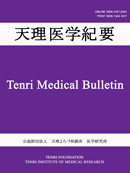Volume 25, Issue 2
Displaying 1-8 of 8 articles from this issue
- |<
- <
- 1
- >
- >|
Original Article
-
2022Volume 25Issue 2 Pages 90-97
Published: December 25, 2022
Released on J-STAGE: December 25, 2022
Download PDF (1909K) Full view HTML
Case Report
-
2022Volume 25Issue 2 Pages 98-105
Published: December 25, 2022
Released on J-STAGE: December 25, 2022
Download PDF (5093K) Full view HTML -
2022Volume 25Issue 2 Pages 106-112
Published: December 25, 2022
Released on J-STAGE: December 25, 2022
Download PDF (7035K) Full view HTML
2021 Symposium of the Tenri Institute of Medical Research
-
2022Volume 25Issue 2 Pages 114-120
Published: December 25, 2022
Released on J-STAGE: December 25, 2022
Download PDF (1503K) Full view HTML -
2022Volume 25Issue 2 Pages 121-125
Published: December 25, 2022
Released on J-STAGE: December 25, 2022
Download PDF (763K) Full view HTML -
2022Volume 25Issue 2 Pages 126-132
Published: December 25, 2022
Released on J-STAGE: December 25, 2022
Download PDF (1513K) Full view HTML -
Article type: 2021 Symposium of the Tenri Institute of Medical Research
2022Volume 25Issue 2 Pages 133
Published: December 25, 2022
Released on J-STAGE: December 25, 2022
Download PDF (255K)
Pictures at Bedside and Bench
-
2022Volume 25Issue 2 Pages 134-138
Published: December 25, 2022
Released on J-STAGE: December 25, 2022
Download PDF (1499K) Full view HTML
- |<
- <
- 1
- >
- >|
